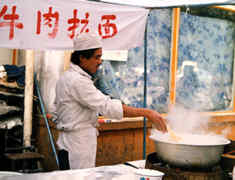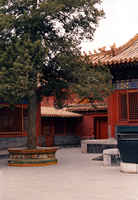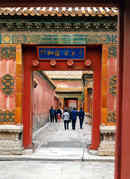 
Click the items below to open a small extra window with
more about
|
 |
 |
 12-18
October 12-18
October
Beijing, dragons and bikes
|
|
In the afternoon of monday, the 12th of October we finally arrive
at our first destination: Beijing. After the quiet of the train
the huge Beijing railwaystation seems crowdy and hectic. Happily
my friend is a seasoned traveller and heads straight for the taxi's
waiting at the front. We pre-booked an hotel for the first few nights,
but on arrival it turns out to be full so we are transferred
to another (rather luxurious as I will notice later in Yangshuo) hotel, the Tao Ran hotel.
|
|
 That
evening we eat our first chinese meal while in China, duck and pineapple,
quite good like most meals we will have the following weeks. We
take the plastic throw-away chopsticks (with which we ate, yes indeed....)
with us for future (hygenic, more so then wooden ones we're told)
use. A stroll in a park, the first letter home and a long night's
sleep later we go back to the hotel we originally booked and where
we are intended to stay the rest of our visit to Beijing. It's a
short ride by taxi-bike, bikes all around us and everybody ringing
their bells. It looks like some crazy rush-hour for bikes, although
it's already the middle of the morning. The streets are litterally
filled with bikes, buses and lorries. That
evening we eat our first chinese meal while in China, duck and pineapple,
quite good like most meals we will have the following weeks. We
take the plastic throw-away chopsticks (with which we ate, yes indeed....)
with us for future (hygenic, more so then wooden ones we're told)
use. A stroll in a park, the first letter home and a long night's
sleep later we go back to the hotel we originally booked and where
we are intended to stay the rest of our visit to Beijing. It's a
short ride by taxi-bike, bikes all around us and everybody ringing
their bells. It looks like some crazy rush-hour for bikes, although
it's already the middle of the morning. The streets are litterally
filled with bikes, buses and lorries.
(Click here for some  extra
photo's of the
Beijing street life) extra
photo's of the
Beijing street life)

The rest of the day we spend buying railwaytickets to Guilin. According to the "Rough Guide to China" there is supposed
to be a special ticket-window for foreigners, but whether we found
it or not, I still don't know. Nobody speaks English, we don't speak
Chinese. We are sent from one ticket window to another, stand in
line then here then there and so on. How it came about I forgot
but a fact is that finally we left the station with 2 tickets to
Guilin for the following friday, in a soft-sleeper, i.e. a 4 person
compartment with semi-soft bunks to sleep and sit on (actually we
had the same kind of sleeper in the Transsiberia Expres), the most
luxurious class (the start of the journey as a whole was kind of
luxurious but I didn't know that at the time). Because of this experience
we decided not to travel within China more then we need to.
to Guilin. According to the "Rough Guide to China" there is supposed
to be a special ticket-window for foreigners, but whether we found
it or not, I still don't know. Nobody speaks English, we don't speak
Chinese. We are sent from one ticket window to another, stand in
line then here then there and so on. How it came about I forgot
but a fact is that finally we left the station with 2 tickets to
Guilin for the following friday, in a soft-sleeper, i.e. a 4 person
compartment with semi-soft bunks to sleep and sit on (actually we
had the same kind of sleeper in the Transsiberia Expres), the most
luxurious class (the start of the journey as a whole was kind of
luxurious but I didn't know that at the time). Because of this experience
we decided not to travel within China more then we need to.
 The
next day we visited the most famous places of Beijing: the Tian-An-Men
square (the square of Heavenly Peace, where 2 years later the army
cut down a pro-democracy demonstration) and the Forbidden City.
The Forbidden City, which used to be the emperors palace and forbidden
to the common people, is very large (720,000 sq metres, 800 buildings
- Lonely Planet says). The entrance is at the southside, the side
where you find the Tian-An-Men square and the further you go north,
the more important the buildings. At the central north-south axis
there are a number of The
next day we visited the most famous places of Beijing: the Tian-An-Men
square (the square of Heavenly Peace, where 2 years later the army
cut down a pro-democracy demonstration) and the Forbidden City.
The Forbidden City, which used to be the emperors palace and forbidden
to the common people, is very large (720,000 sq metres, 800 buildings
- Lonely Planet says). The entrance is at the southside, the side
where you find the Tian-An-Men square and the further you go north,
the more important the buildings. At the central north-south axis
there are a number of  ceremonial buildings, bearing names like "Hall of Supreme Harmony","
Gate of Heavenly Purity" and "Palace of Earthly Tranquility".
These buildings are located at enormous courtyards. To the left
and right of the main ceremonial buildings are, especially at the
northern end, other buildings and palaces which are now used for
displays and exhibitions. At the very back, in the middle there
is the Imperial Garden, a classical Chinese garden with rockeries,
goldfish and the "Thousand Autumns Pavillion".
ceremonial buildings, bearing names like "Hall of Supreme Harmony","
Gate of Heavenly Purity" and "Palace of Earthly Tranquility".
These buildings are located at enormous courtyards. To the left
and right of the main ceremonial buildings are, especially at the
northern end, other buildings and palaces which are now used for
displays and exhibitions. At the very back, in the middle there
is the Imperial Garden, a classical Chinese garden with rockeries,
goldfish and the "Thousand Autumns Pavillion".


| |
Another imperial sightseeing object, Tiantan, the Temple of Heaven
(see Add On Menu or click
here for extra photo's and information) we saw the next day.
This temple, situated in a large park, was used for religious ceremonies
performed by the emperor, the son of Heaven, like the annual prayer
for a good harvest.
Detail
of the Temple of Heaven:

  We
also went to YongheGong, the Lama Temple, the most renown Tibetan
Buddhist temple within China outside Tibet itself. The temple buildings,the
most important are five halls in a line, each taller then the preceding
one, are located in nice gardens with courtyards and galleries.
It is a lamasery since 1744, and it survived the Cultural Revolution
miraculously without scars. It was restored expansively in 1979
as a symbol of religious freedom and national unity. We
also went to YongheGong, the Lama Temple, the most renown Tibetan
Buddhist temple within China outside Tibet itself. The temple buildings,the
most important are five halls in a line, each taller then the preceding
one, are located in nice gardens with courtyards and galleries.
It is a lamasery since 1744, and it survived the Cultural Revolution
miraculously without scars. It was restored expansively in 1979
as a symbol of religious freedom and national unity.
Beijing is a huge town but to get around we walked most of the
time, sometimes we went by bus. Walking the streets we saw a bit
of the "real" Beijing.  As
stated before the streets were filled by many bikes, buses and lorries.
(I went to Beijing again in 1992 it was very different then!). Even
washing-machines and fridges were transported by bike (tricycles)!
Many people were dressed in the famous blue "Mao"-suits.
The main streets were all broad, with trees at both sides. At the
corners of big crossroads there were (meant as a warning I presume)
displays of bloody pictures of the accidents that happened there
in the past. As
stated before the streets were filled by many bikes, buses and lorries.
(I went to Beijing again in 1992 it was very different then!). Even
washing-machines and fridges were transported by bike (tricycles)!
Many people were dressed in the famous blue "Mao"-suits.
The main streets were all broad, with trees at both sides. At the
corners of big crossroads there were (meant as a warning I presume)
displays of bloody pictures of the accidents that happened there
in the past.
It is impossible to get to know a huge city like Beijing within
a few days. And that goes for many of the places we've seen by the
way)but we had our traintickets, so after four days we went south,
to Guilin.. We left late at night friday, the 16th of october and
spent the whole saturday in the train. We shared the compartment
with two Chinese women, an aunt and her cousin from Hong Kong. They
hardly spoke any English en the little Chinese I knew and that was
in my "How to speak Chinese" book apeared to be the wrong
kind of Chinese (Mandarin, instead of Cantonese what the ladies
spoke, altough the signs are the same) nevertheless we had some
nice talks wih them. Sundaymorning, at 6 o'clock, we got off the
train, put on our rucksacks, on to the Guilin bus-station looking
for a bus to Yangshuo........


On the road from Beijing to Guilin
|
|
|
|


